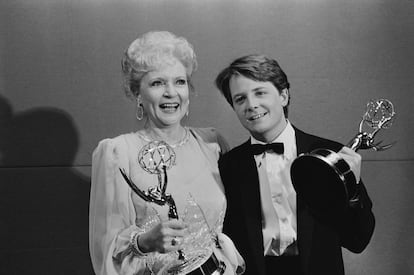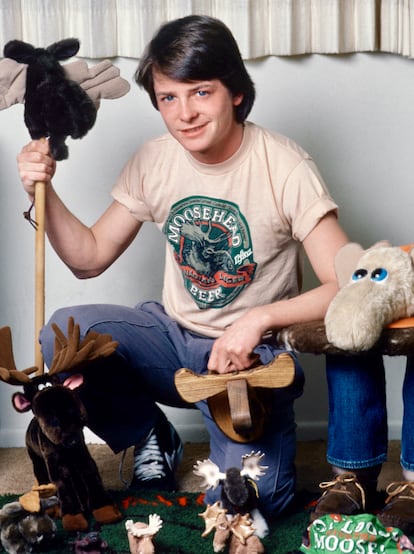Michael J. Fox: First he defied Hollywood, then Parkinson’s disease
The documentary ‘Still’ charts the life of the ‘Back to the Future’ star, who managed to mitigate the impact of a cruel disease on his career by combining the two

“This is not the kind of face you’ll ever see on a lunchbox!” said Brandon Tartikoff, president of NBC, when discussing whether Canadian-American actor, Michael J. Fox, 61, was right for the series Family Ties. Having hits such as The Golden Girls and Miami Vice in his arsenal, Tartikoff’s opinion was considered infallible, but in this instance he was wrong. Months later, it was impossible to get away from Fox’s face. It appeared on magazines, posters, T-shirts — and lunchboxes. To show Tartikoff he held no grudge, Fox sent him a gift: a lunchbox with his face on it and a note: “To Brandon. This is for you to put your crow in. Love and kisses, Michael J. Fox.”
"This is not the kind of face that you’ll ever see on a lunchbox.”
— Brandon Tartikoff (@BTartikoff) August 14, 2018
It's good to be wrong! This stayed on the desk even after leaving NBC. From Michael .....“To Brandon: This is for you to put your crow in. Love and Kisses, Michael J pic.twitter.com/GN8RJJLVFo
Fox’s success was not easily predictable. Short and excessively neat with no hint of a 5 o’clock shadow, he did not fit with the early eighties ideal, inspired by the cast of Francis Ford Coppola’s Outsiders. There was nothing wild about him; he didn’t exude sexuality, he wasn’t Matt Dillon, much less Mickey Rourke. He ticked none of the boxes, but it worked all the same. He starred in a series of box office hits, high-rating series, comedies and edgy dramas. He had a good run until, at the age of 29, a tremor in his index finger prompted a visit to the doctor. What he thought was merely a symptom of a bad hangover was, in fact, the first symptom of Parkinson’s disease. The doctors predicted his career might last another 10 years at best, but, once again, he confounded expectations.
“I’ve thought about the mortality of it; I’m not going to be 80,” he declared last week on CBS’ Sunday Morning Show. “I’m not going to lie, it’s getting harder. It’s getting tougher, every day is getting tougher. But that’s the way it is. Who do I see about that?” The last 30 years of his life have been dominated by Parkinson’s, a daily struggle that is reflected in the documentary Still: A Michael J. Fox Movie, to be released on May 12, by Apple TV+.

Its director, Davis Guggenheim, is married to actress Elisabeth Shue, who played Fox’s girlfriend in Back to the Future Part II, which gives Guggenheim, apart from obvious familiarity with his subject, a deep insight into what it meant to be a star in 1980s teen cinema, a time when a group of youngsters, including Shue herself, became overnight stars only to lose their luster with comparable speed.
A turn of events
There are many actors who owe their careers to a last-minute change-of-mind, and Fox is a prime example. Eric Stoltz had been playing Marty McFly for six weeks when director Robert Zemeckis fired him and hired Fox. Stoltz was a method actor who dressed and behaved like his character and asked to be called Marty off set. His professionalism was beyond question, but Zemeckis was not satisfied with the result. For Stoltz, the plot was dramatic: the story of a boy whose memories will never match his true past. From his point of view, Back to the Future was an existential drama that could have been filmed by Alain Resnais, the man behind Last Year at Marienbad, but for the director and producers it was a lighthearted comedy aimed at teenage audiences for which Stoltz did not have the right approach.
Fox had been the first choice for the role, but NBC wouldn’t budge on his contract for Family Ties, its flagship series. TV commitments have been poison for a handful of careers: Magnum was the reason why Tom Selleck was never Indiana Jones and Remington Steele postponed Pierce Brosnan’s Bond role. Finally, NBC agreed to negotiate and Fox combined the two shoots: he would film the series from 10 a.m. to 6 p.m., and then drive to Universal to shoot with Zemeckis from 7 p.m. to 3 a.m. With Fox on board, all the pieces fell into place. His chemistry with Christopher Lloyd was instant, the comedy flowed and even the red padded vest he wore one morning because it was cold on set, became iconic.

The film was a runaway success. It grossed almost $400 million. Aware of the blockbuster they had on their hands, Universal rushed to produce the sequel and, to avoid scheduling problems, they simultaneously arranged the filming of the third installment.
Fox’s charisma
Before Family Ties, Fox was an unknown Canadian teenager whose background was limited to roles in series like Lou Grant. At the time, it was impossible to predict the phenomenon he would become, so much so that he forced a change in the premise of a series in which he was to play a supporting role. The stars of the series were two 1960s hippies whose children turn out to be much more conservative and traditional than they were, but Fox’s charisma meant that, halfway through the first season, his character, Alex P. Keaton, a dapper teenager in a suit who quoted economist Milton Friedman and whose only desire was to be a millionaire, moved to the center of the narrative.
It became one of the most popular sitcoms of the era. Ronald Reagan named it his favorite series and young Republican politicians cited Keaton as their reference. For the first time, being a young conservative was considered sexy. Plus, Fox was the rebel, something that had not remotely been the screenwriters’ intention.
The man whose face wasn’t going to appear on a lunchbox was on the cusp of stardom and he was having a hard time digesting it. Just five minutes before he was offered the role of Keaton, he said, “I had no phone, no couch, no money. I was so depressed I would have accepted any role.” Family Ties brought him three Emmy Awards and a Golden Globe, not to mention his wife, actress Tracy Pollan, with whom he has four children.

With Back to the Future still showing in movie theaters, he released Teen Wolf (1985), an earlier project that had postponed its screening to take advantage of Fox’s sudden popularity and that today is something of a cult movie, even though the actor doesn’t have fond memories of it. “Looking back, I have no idea what I was thinking when I said I would do it,” he remarked. Comedies like Herbert Ross’s The Secret of My Success (1987) assured him box-office success, but he wanted to take risks. Together with singer Joan Jett, he shot Rock Star (1987) under the direction of Paul Schrader, the screenwriter of Taxi Driver, which bombed. He had no better luck with Bright Lights, Big City (1988), in which he played an aspiring writer who ends up ruined by New York nightlife. Fox had joined the project to extend his range as an actor, but it ended up being edited to eliminate the scenes in which he took drugs for fear of damaging his image. “To fail doing something unexpected is no disgrace. To fail doing the ordinary is a disaster,” he told The New York Times.
The day everything changed
While shooting Doc Hollywood (1991), the story of a Beverly Hills plastic surgeon rediscovering himself in a small town, Fox’s life took a turn for the worse. “I woke up to find the message in my left hand,” he wrote in his memoirs. “It had me trembling. It wasn’t a fax, telegram, memo or the usual sort of missive bringing disturbing news. In fact, my hand held nothing at all. The trembling was the message.” His first thought was that he and Woody Harrelson, his co-star, had had too many beers the night before. Then, the nightmarish search for a diagnosis began. A year later, he had the answer: Parkinson’s, a degenerative disease with no cure and which affects more than a million Americans with symptoms including tremors, slowness of movement, balance problems and stiffness.

He had just gotten married and his wife was pregnant. He was only 29 and he decided to keep the disease under wraps. “Would they still think I was funny if they knew I had Parkinson’s?” he asked. He started drinking too much, until one day he woke up on the couch drunk with half a can of beer on the floor, his son asleep on top of him and his wife staring at him. “She didn’t look angry or upset, but worse, indifferent,” he said. He never drank again.
Although the symptoms were becoming more and more evident, he continued working. Impressed with Heavenly Creatures, he called Peter Jackson to star in The Frighteners (1997), an offbeat horror comedy that, despite its merits, slipped under the radar, and he was also part of the stellar cast of Tim Burton’s Mars Attacks! (1996). He took dopamine to help stave off the early symptoms of the disease and tried to hide his arms so the tremors would go unnoticed. “I became a virtuoso of manipulating drug intake so that I’d peak at exactly the right time and place,” he said. At the time, he was starring in the TV sitcom Spin City (1996-2002). During the third season, he gathered the crew together and admitted what was going on. “I spent seven years in denial,” he said as he picked up an honorary Oscar at the Academy Awards last year. “I only knew that it would get worse.” After an Emmy Award and three Golden Globes, he left Spin City and was replaced by Charlie Sheen.

Fox not only acknowledged in public that he suffered from Parkinson’s: like other celebrities such as Selma Blair and Christopher Reeve, he became a tireless activist, setting up the Michael J. Fox Foundation for Parkinson’s Research in 2000 which has raised more than €1 billion to date and is one of the main voices in favor of stem cell research, anathema to the Republican Party.
Until he retired for good in 2019, he continued to string together appearances on television, some as notable as his self-parody in Larry David, or his role as Louis Canning in The Good Wife, in which again his charisma forced a change in the script: he was going to play Louis in just one episode and ended up in twenty-six. In both cases, the joke was in the fact that the disabled person stopped being a victim and used the disease to his advantage. “My whole idea behind this guy [in The Good Wife], it was a real simple concept,” he told fellow actor Denis Leary at the ATX TV Festival. “I just thought that people see a wheelchair or see someone with a disability on television and the music gets soft and hazy. Handicapped people can be assholes too. Handicapped people can be jerks and manipulative, and so it was fun to play one.”
Sign up for our weekly newsletter to get more English-language news coverage from EL PAÍS USA Edition
Tu suscripción se está usando en otro dispositivo
¿Quieres añadir otro usuario a tu suscripción?
Si continúas leyendo en este dispositivo, no se podrá leer en el otro.
FlechaTu suscripción se está usando en otro dispositivo y solo puedes acceder a EL PAÍS desde un dispositivo a la vez.
Si quieres compartir tu cuenta, cambia tu suscripción a la modalidad Premium, así podrás añadir otro usuario. Cada uno accederá con su propia cuenta de email, lo que os permitirá personalizar vuestra experiencia en EL PAÍS.
¿Tienes una suscripción de empresa? Accede aquí para contratar más cuentas.
En el caso de no saber quién está usando tu cuenta, te recomendamos cambiar tu contraseña aquí.
Si decides continuar compartiendo tu cuenta, este mensaje se mostrará en tu dispositivo y en el de la otra persona que está usando tu cuenta de forma indefinida, afectando a tu experiencia de lectura. Puedes consultar aquí los términos y condiciones de la suscripción digital.
More information
Archived In
Últimas noticias
Most viewed
- Reinhard Genzel, Nobel laureate in physics: ‘One-minute videos will never give you the truth’
- Oona Chaplin: ‘I told James Cameron that I was living in a treehouse and starting a permaculture project with a friend’
- Pablo Escobar’s hippos: A serious environmental problem, 40 years on
- Why we lost the habit of sleeping in two segments and how that changed our sense of time
- Charles Dubouloz, mountaineering star, retires at 36 with a farewell tour inspired by Walter Bonatti











































